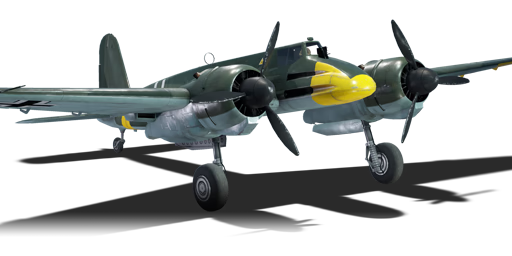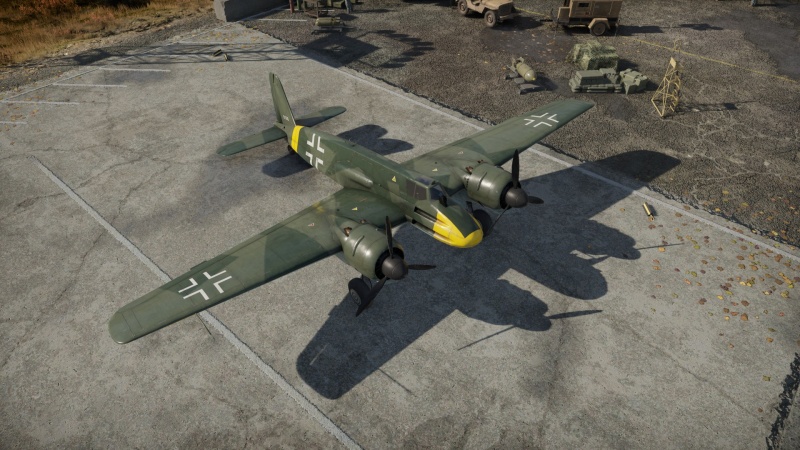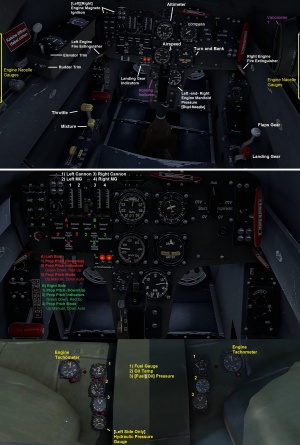Hs 129 B-2
| This page is about the German strike aircraft Hs 129 B-2. For other versions, see Hs 129 (Family). |
Contents
Description
The Henschel Hs 129 is a ground attack aircraft deployed by the Luftwaffe during World War II. The Hs 129 was originally designed in 1937 to a specification for a heavily armoured, twin-engined ground attack aircraft that would utilise an engine not used on any aircraft in mainline production, so as not to disrupt the production of more proven designs. Originally, the Hs 129 was powered by two Argus As 410 engines - a lightweight engine designed for light aircraft such as the Fw 189 reconnaissance plane, with 465 hp each. However, the Argus engine proved to be severely underpowered for the Hs 129's airframe, resulting in it being very difficult to fly. The "saving grace" for the Hs 129 came in 1940 after the fall of France, in the form of a stockpile of French Gnome-Rhône 14M radial engines with 690 hp each. While still underpowered, these were just powerful enough to keep the plane in the air should it not be damaged.
Despite these shortcomings, the Hs 129 proved to be a dependable design. The type was used extensively on the Eastern Front, while some also saw combat in Tunisia. Some of the main production B-2 variant were sold to Romania and Hungary in 1943. Various variants of the Hs 129 were produced, including one modified to mount a huge 75 mm anti-tank cannon in an attempt to counter heavier Soviet tanks.
In the game since the start of the Open Beta Test prior to Update 1.27, the Henschel Hs 129 B-2 is a ground attack aircraft, designed primarily to take out tanks and armoured vehicles and fulfil other roles associated with CAS. Both the 30 mm MK 103 and 37 mm BK 3.7 cannons are capable of knocking out medium tanks, light tanks, and light pillboxes, while the 20 mm cannons can easily destroy armoured cars, mobile AAAs, and other lightly armoured equipment. The plane is both slow and sluggish, meaning that it practically has to go after ground targets, but the armament and armour somewhat compensate for this, enabling it to take out nearly all ground targets except for pillboxes and heavy tanks. It is also capable of shredding any enemy aircraft that dares to face it head-on.
General info
Flight performance
| Characteristics | Max Speed (km/h at 3,550 m) |
Max altitude (metres) |
Turn time (seconds) |
Rate of climb (metres/second) |
Take-off run (metres) | |||
|---|---|---|---|---|---|---|---|---|
| AB | RB | AB | RB | AB | RB | |||
| Stock | 421 | 404 | 29.4 | 31.3 | 5.9 | 5.9 | 331 | |
| Upgraded | 466 | 439 | 26.5 | 27.9 | 11.2 | 8.2 | ||
Details
| Features | ||||
|---|---|---|---|---|
| Combat flaps | Take-off flaps | Landing flaps | Air brakes | Arrestor gear |
| ✓ | ✓ | ✓ | X | X |
| Limits | ||||||
|---|---|---|---|---|---|---|
| Wings (km/h) | Gear (km/h) | Flaps (km/h) | Max Static G | |||
| Combat | Take-off | Landing | + | - | ||
| 287 | 252 | 190 | ~10 | ~6 | ||
| Optimal velocities (km/h) | |||
|---|---|---|---|
| Ailerons | Rudder | Elevators | Radiator |
| < 310 | < 320 | < 300 | > 230 |
| Compressor (RB/SB) | ||
|---|---|---|
| Setting 1 | ||
| Optimal altitude | 100% Engine power | WEP Engine power |
| 3,000 m | 1,300 hp | 1,530 hp |
Survivability and armour
- 5 mm Steel - Oil cooler covers
- 5 mm Steel - Lower engine cowl protection
- 6 mm Steel - Cockpit side plates
- 12 mm Steel - Cockpit back plate, floor, and front plates
- 75 mm Bulletproof glass
Modifications and economy
Research Path:
- Radiator
- ETC 50/VIIId
- R2 modification
- All Flight Performance/Survivability
- Weaponry
- BK 3,7 (last)
Armaments
Offensive armament
The Hs 129 B-2 is armed with:
- 2 x 20 mm MG 151 cannons, fuselage-mounted (250 rpg = 500 total)
- 2 x 7.92 mm MG 17 machine guns, fuselage-mounted (1,000 rpg = 2,000 total)
Suspended armament
The Hs 129 B-2 can be outfitted with the following ordnance:
- Without load
- 1 x 30 mm MK 103 cannon, belly-mounted (100 rpg)
- 1 x 37 mm BK 3.7 cannon, belly-mounted (12 rpg)
- 4 x 50 kg SC50JA bombs (200 kg total)
Usage in battles
The plane is very heavy, which makes it nearly impossible to take out fighters (unless the fighters come to the Hs 129 B-2, see below), even most medium bombers are more manoeuvrable, however the plane is heavily armoured, so it can last a while even under heavy fire, even to such a degree that some planes run out of ammunition before taking out a Henschel. That combined with the heavy armament makes it ideal to attack B-17 formations, even though it requires time and effort to climb and match the speed of the formation. The armour around the cockpit makes it nearly immune to 7.92 mm rounds and could also fly with one engine, albeit with great difficulty. The planes incredibly stable flight behaviour makes aiming even for joystick pilots very easy and accurate thus not wasting too much ammunition.
Once the 30 mm additional gun with its impressive 100-round belt has been researched (the 37 mm with its smaller belt and low rate of fire should be avoided), the plane has very heavy firepower. In combination with the great stability and thus firing accuracy, this makes it an ideal heads-on fighter. With a bit of experience, it's relatively easy to finish off enemy fighters with one or two short bursts before they are even in range for the target indicator to appear. In situations where enemy planes coming at 0.5 to 1.0 km interval from the same direction, the Hs 129 B-2 can easily achieve triple or even quadruple air victories before needing to turn around for reloading.
Tactics
Using the 30 mm MK 103, which can be unlocked as an additional armament option, the Hs 129 B-2 is capable of destroying most mission relevant ground targets. Tanks of all sorts, as well as light pillboxes, can be destroyed in up to three hits, provided armour piercing ammunition (HVAP-T) is unlocked. Thanks to the 100 rounds of ammunition available, this can make a single Hs 129B-2 a game-changing aircraft. The same can be achieved using the BK 3.7, however, it is generally considered harder to use and thus not a viable option.
The Hs 129 B-2, however, does have major drawbacks. Its engines are weak which results in poor top speed, acceleration and climb rate. This, combined with the armour of nearly one-ton weight, makes it perform poorly in air combat and very vulnerable to attacks of enemy fighters. This, however, goes so far that sometimes enemy pilots underestimate the Hs 129 and overshoot it after a tight turn, which gives the Hs 129B-2 pilot a moderate chance of defending itself.
Enemies worth noting:
Yak-2 KABB - Do not think that the Hs 129 B-2 can confidently outmanoeuvre this plane just because it is twin-engined. The Yak-2 has an amazing turn rate for a heavy fighter, thus the Hs 129 B-2 must avoid turning with it, if not dogfighting with it in general. It bears a pair of ShVAK cannons that can easily damage vital parts like engine or cooling systems. It has green camouflage, greatly resembling an Me 410 but with an H-tail like a Bf 110's.
ZSD63 - A deadly enemy to face in Tank Realistic Battles. Though it is hard to identify specific SPAA vehicles on the ground (especially when they are shooting tracers at the plane), if a ZSD63 is identified, avoid it at all costs and do not attempt head-ons with it, ever. It can easily snap a wing off by causally putting a short burst in the Hs 129 B-2's flight path. Don't even get close to it unless it is occupied with another friendly or if the Hs 129 B-2 is equipped with a bomb that it can use. The Hs 129 B-2's 30 mm or 37 mm cannons in the secondary armaments cannot effectively damage it as its hull is overall quite empty, causing your shells to do little to no damage. Some identifying features of the ZSD63 is its rather boxy and tall hull with a geometric turret sitting at the back, slightly similar to a Wirbelwind's. The firing manner is also distinctive: the sound and green tracers are very rapid, much like a buzz saw, but then it will remain silent for half a minute reloading. Note that an experienced ZSD player will hold its fire or shoot in single salvoes with long halts between, making it look like that it's reloading. The armour-piercing belt is recommended since its high penetration can tear through the ZSD's armour with ease and knock out its crews.
Manual Engine Control
| MEC elements | ||||||
|---|---|---|---|---|---|---|
| Mixer | Pitch | Radiator | Supercharger | Turbocharger | ||
| Oil | Water | Type | ||||
| Not controllable | Controllable Not auto controlled |
Controllable Not auto controlled |
Not controllable Not auto controlled |
Separate | Not controllable 1 gear |
Not controllable |
Pros and cons
Pros:
- Resistant to light machine guns and Soviet heavy machine guns
- Very good firepower when carrying either the 30 mm or 37 mm cannon pods
- 30 mm MK 103 is a high-velocity cannon with a decent rate of fire, which allows for versatility in targets, and is especially devastating against armoured vehicles
- 30 mm HVAP-T generally destroys air targets in one to three hits with a high potential to combust targets
- 30 mm HE-I/HEI-T Minengeschoß in the default belts means grinding once the 30 mm is available isn't that difficult
- 30 mm has a reasonable ammo pool of 100 rounds and the low fire rate combined with hit success allows it more than enough to obtain down five planes before running out
- Cockpit has 75 mm of armoured glass at the front, reasonable all-round protection for the pilot
- Great at head-on passes in all game modes (shoot and duck/roll away)
- Centrally mounted armament, need for gun harmonisation minimalized
Cons:
- Poor climb rate, bad manoeuvrability, heavy aircraft
- The engines are underpowered and if even one is shot-up, the plane will fall from the sky
- Engine uses a carburettor, preventing prolonged inverted G-load state
- Has no defensive armament compared to other attack aircraft of its rank
- Engine and internal wing fuel tanks are ideal targets for enemy pilots
- Needs the gun pods to do well
- Cockpit armour is very thin
- Pilot can be killed by SPAAGs or by machine guns larger than .30 cal
- Thick cockpit armoured glass causes some distortion (Simulator)
History
| Archive of the in-game description | |
|---|---|
|
The German Henschel Hs 129 was a single-seater twin-engine attack aircraft built for combat with tanks. For the designers of the Henschel firm, which specialized in the manufacture of armoured vehicles for the Army, the most difficult challenge was aircraft survivability. They sought to protect the pilot and the most vulnerable components of the aircraft. Their desire to keep mass as low as possible led them to build a cockpit encased in 75 millimeters of glass. The design was very cramped and poorly regarded. Among other inconveniences were the tiny control panel and short control stick. During flight testing, it was found that the aircraft could not dive, since any angle greater than 30 degrees resulted in the pilot being unable to control the aircraft. In addition, it was found that the Hs 129 could not fly well on one engine. This fact, combined with the reasoning that the plane could land using the other engine should its partner fail, led to the plane's twin-engine design. Despite the plane's shortcomings, the Luftwaffe desperately needed aircraft for the assault of 1940, and in the winter of 1940, Henschel received an order for a series of Hs 129 planes. With the occupation of France, a large number of Gnome-Rhone 14M engines were confiscated, each running at 700 hp. Experiments with installing more powerful (albeit unreliable) engines led to the creation of the Hs 129B, which had superior specs to the original Hs 129 and could return all the way to base if forced to fly with only one engine. Serial production of the Hs 129B-1 began in 1941, and May of the following year saw the launch of the modified Hs 129 B-2, which had a modified fuel system (along with several other minor changes). All in all, 878 Hs 129s were produced. | |
Media
See also
- Related development
External links
| Henschel & Son Corporation (Henschel und Sohn Aktiengesellschaft) | |
|---|---|
| Attackers | Hs 129 B-2 · Hs 129 B-3 |
| Bombers | Hs 123 A-1 |
| Export | ␗Hs 123 A-1 |
| Hs 129 B-2 (Romania) · Hs 129 B-2 (Romania) | |
| Germany strike aircraft | |
|---|---|
| Messerschmitt | |
| Bf 110 | Bf 110 C-6 · Bf 110 C-7 · Bf 110 F-2 · Bf 110 G-2 · Bf 110 G-4 |
| Me 410 | Me 410 A-1 · Me 410 A-1/U4 · Me 410 B-1 · Me 410 B-2/U4 · Me 410 B-6/R3 |
| Dornier | |
| Do 335 | Do 335 A-0 · Do 335 A-1 · Do 335 B-2 |
| Focke-Wulf | |
| Fw 190 | Fw 190 F-8 |
| Heinkel | |
| He 219 | He 219 A-7 |
| Henschel | |
| Hs 129 | Hs 129 B-2 · Hs 129 B-2 (Romania) · Hs 129 B-3 |
| Junkers | |
| Ju 87 | Ju 87 G-1 · Ju 87 G-2 |
| Foreign: | |
| USSR | ▀IL-2 (1942) |






